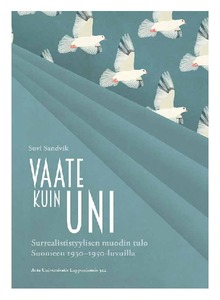Vaate kuin uni : surrealististyylisen muodin tulo Suomeen 1930–1950-luvuilla
Sandvik, Suvi (2016)
Sandvik, Suvi
Lapin yliopisto
2016
ISBN:978-952-484-894-7
openAccess
Julkaisun pysyvä osoite on
https://urn.fi/URN:ISBN:978-952-484-894-7
https://urn.fi/URN:ISBN:978-952-484-894-7
Kuvaus
ei tietoa saavutettavuudesta
Tiivistelmä
Some Finnish garments from the 1930s–1950s with bowtie-, butterfly-, bird-, plant-, and sea-related decorations – referred to as “bibelot” in my study – resemble clothes designed by Parisian surrealist fashion artists. Although the roots of surrealism lie in Parisian literature, its influence soon became apparent in visual art and fashion as well. In the 1930s, fashion was affected by surrealism’s provocativeness.
This investigation on clothing design and fashion is focused on the 1930s, 1940s, and 1950s. The phenomena of today have roots in our past. This study provides tools for other researchers to convey some of the past into the present. My aim is to observe surrealist features in Finnish fashion through pictures and clothes, and to investigate the connection of fashion designers with their era and work by examining the arrival of surrealist fashion in Finland and its application to Finnish women’s clothing. In addition, I look into the views expressed through the clothing about contemporary societal situations.
The designers of the analyzed 24 dresses were journalist Linda Eerikäinen (1894–1993) as well as the following fashion designers: Aili Salli Ahde-Kjäldman (1892–1979) from La Robe, Nina Bergman (1899–1984) from Atelier Nina Bergman, Marusa Brunow from Salon Ika, and Kaarlo Forsman (1907–1994) from Salon Kaarlo Forsman. The research material includes pictures of surrealist dresses designed by foreign fashion designers, as well as pictures of surrealist works of art forming the reference material of my study. In particular, I refer to dresses designed by Parisian fashion designer Elsa Schiaparelli, and to the works of Salvador Dali and Pablo Picasso because of their substantial influence on visual art.
This investigation on clothing design and fashion is focused on the 1930s, 1940s, and 1950s. The phenomena of today have roots in our past. This study provides tools for other researchers to convey some of the past into the present. My aim is to observe surrealist features in Finnish fashion through pictures and clothes, and to investigate the connection of fashion designers with their era and work by examining the arrival of surrealist fashion in Finland and its application to Finnish women’s clothing. In addition, I look into the views expressed through the clothing about contemporary societal situations.
The designers of the analyzed 24 dresses were journalist Linda Eerikäinen (1894–1993) as well as the following fashion designers: Aili Salli Ahde-Kjäldman (1892–1979) from La Robe, Nina Bergman (1899–1984) from Atelier Nina Bergman, Marusa Brunow from Salon Ika, and Kaarlo Forsman (1907–1994) from Salon Kaarlo Forsman. The research material includes pictures of surrealist dresses designed by foreign fashion designers, as well as pictures of surrealist works of art forming the reference material of my study. In particular, I refer to dresses designed by Parisian fashion designer Elsa Schiaparelli, and to the works of Salvador Dali and Pablo Picasso because of their substantial influence on visual art.
Kokoelmat
- Väitöskirjat [415]
